
|

|
Concise history from Phil Butler's 'War Prizes':
AM219 Messerschmitt Me 163B WNr 191659
Coded 'Yellow 15' of JG400. Surrendered at Husum and shipped to the RAE. Despatched from Farnborough to No.6 MU, Brize Norton, on 26th July 1945. AM 219 was at No. 6 MU for the Census of 21st March 1946 but was despatched to the College of Aeronautics, Cranfield (subsequently the Cranfield Institute of Technology) on 19th May 1947. Except for brief periods of exhibition elsewhere (e.g. Upwood Battle of Britain displays) AM219 remained in the 'Library of Flight' at Cranfield until 1975 when it went to Marshall's of Cambridge Ltd. at Cambridge Airport for refurbishing prior to display at the Royal Scottish Museum of Flight at East Fortune airfield to the east of Edinburgh in 1976. It is currently on display there.
One source reports that it was originally coded 'Yellow 14'.
No details available yet. The following photo was possibly taken here. It shows the original mottle pattern of the tail. G-AKAG in the back is a Liberator C.VII (C-87-CF), formerly EW611 and 44-39219.

|

|
Not many details of this period have been uncovered. The Komet was part of Cranfield's 'Library of Flight' collection, consisting of a big hangar filled with peculiar aircraft. The following two pictures are thought to be taken at Cranfield, but this has yet to be confirmed. In 2019, a similar photo from the J.J. Halley archive appeared on Ebay, with the notes '191659 White Waltham 14.5.50 MMG' on the back, so White Waltham (a small general aviation aerodrome) is another possibe location. These photos were kindly supplied by Grant Newman of the Museum of Flight at East Fortune, where this very Komet now can be found.

|

|
John Hinton kindly supplied this photo, made in the 1964-1966 time frame. Compared to the previous photos, the swastika has been filled in with black.
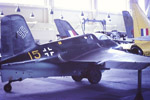
|
The following pictures from Air BP from 1967 give a good impression of this Komet's time at Cranfield. The presence of a TSR2 means the pictures were taken in 1966 or 1967. It appears that some repainting has taken place: the swastika is now black-filled, and the mottle pattern is different.

|

|

|

|

|

|
Another photo from the Cranfield period was found by John Buckley in an old Scale Models magazine.

|
One source reports it "wore at some time Yellow 15", indicating it sometimes lacked a code?
Another small piece of history of this Komet was found by Grant Newman of the Museum of Flight in Flypast magazine. In a letter, Mr. G. Dexter (then in the RAF) recalled how he picked up this Komet at Cranfield for display during an open day at his base RAF Upwood in 1951. At Cranfield they were told "Help yourself but let us know what you take".
The Museum of Flight is located some 22 miles east of Edinburgh on the former RAF East Fortune. East Fortune has a long aviation history, being established in 1915 as a fighter and airship base. During WWII it served as a training base with aircraft such as Masters, Magisters, Oxfords, Defiants, Blenheims, Beaufighters and Mosquitos. After a long quiet period, in 1971 one of the remaining hangars was aquired by the Royal Scottish Museum. This grew into a new museum, the Museum of Flight, that opened in July 1975. Since then the collection expanded to some 50 aircraft and 10 missiles.
The extensive report presented below was researched and compiled by Shamus Reddin, with comments on the engine by Reinhold Stadler.
Captured in May 1945, this aircraft was donated to the College of Aeronautics at Cranfield in 1947. Following a long period displayed at the college's "Library of Flight" museum, 191659 was then donated on long term loan to the Museum of Flight at East Fortune Airfield in Scotland, following refurbishment at Marshall of Cambridge's Aircraft Works. Previous sources have listed the acquisition as 1975 and the move to Scotland the following year in 1976. However, documents examined at East Fortune seem to suggest that the aircraft was transported from Marshalls on a low loader sometime between 20th March and 30th April 1975.
For a considerable period on long term loan, the aircraft is now wholly owned by the Museum of Flight. Upon donation to the Museum of Flight the aircraft has been kept on permanent display to the public. Whilst not neglected at Cranfield (it was displayed missing a number of panels, notably at the wing roots and alongside the landing skid), the lack of extensive restoration on its outward appearance gave rise to some adverse comments upon its airing at East Fortune, much to the disappointment of the Scottish museum. With a growing collection and commitments in many areas, funding is always an issue. However, over time a number of improvements have been made to the airframe to bring it up to a more aesthetically pleasing display condition.
For a long time this Komet was displayed in Hangar Number 1 at East Fortune, but the museum has subsequently re-organised its exhibits, and the Komet now resides in Hangar Number 4. The Komet's journey across the airfield was made on its own wheeled dolly, carefully manhandled by museum staff. Two new stands were then made, and the airframe now rests with its weight on the bottom of the dolly and on the tailwheel axle, taking the load off all three tyres. Around March 2000 the Komet was moved back to Hangar 1 alongside the Spitfire.
Although it has not undergone extensive restoration, the curatorial staff at East Fortune have taken steps to restore the airframe's appearance, by correcting a number of significant flaws in 191659's display condition. In 1993 work was begun to fabricate a new set of panels from sheet aluminium to patch the exposed areas around the port upper wing root, and port and starboard landing skid fairings. Before these were fitted, work was done to clean and rust inhibit the compressed air piping and bottle reservoirs in the wing root. Interestingly, the more complex shapes around the forward part of the landing skid, and the rudder actuating linkage on the port tail fin were fabricated from glass fibre -between 1995 and 1996.
In the first part of 1996, East Fortune engineers turned a pitot head mock-up on a lathe and added the missing pitot extension tube. Some re-skinning of flap and aileron fabric surfaces has also been done, although the good quality of this work makes telling the new fabric from the original fabric difficult.
There is no record of any extensive strip down restoration work on the airframe since the war, so it is as original as most Komets. However, the wartime camouflage scheme has been overpainted on a number of occasions, probably both at Cranfield and East Fortune. The bulk of painting was apparently done before arrival at Scotland, and at the moment it is not clear whether this was done at Cranfield or Marshalls. Since then, more painting has been done to cover faded areas and the panel restoration work.
Nevertheless, a significant number of patches of what could be original paint are still visible. Preserved paint patches are mainly around areas of stencilling, many of which have, with great forethought, not been obscured by subsequent painting. The stencilling is in several different styles, and may be original, or may represent a previous attempt at re-painting and labelling the airframe (much as was painted onto Duxford's Komet before its current restoration). Further study of these markings is required. Some previous "Sauerstoff" stencil markings around the oxygen connector which were at one time visible, have now been overpainted, but the majority have escaped covering.
The cockpit canopy was rather perilously attached, the fuselage fastenings being loose, but new attachment bolts have been fitted - although for the sake of safety, these are not of an original pattern.
The upper surfaces are now a dark green, gloss cellulose, with that single colour very nearly covering the whole area. However, in two areas, one on each wing, there is an area of matt, dark green paint, which may be the last vestige of the original splinter camouflage.
191659 now has a yellow nose, with a ring of black separating this from the fuselage colours. On the fuselage sides, the code "15" is painted in yellow, outlined in black. Some documents suggest this is an original code, but there has been extensive overpainting, so there is no current physical evidence to confirm this. Fuselage Balkenkreuz is white, and the tail Hakenkreuz is black outlined in white. "C Stoff" and "T Stoff" stencils are standard colours, although the position of the "C Stoff" stencil on the fuselage spine is slightly to the rear of the common position. Werknummer "191659" is in black, only on the port tail fin. The font style does not look original.
Under surfaces are a mixture of three colours of light blue. Around some of the original (?) stencils are patches of a pale blue/green, slightly speckled paint. Most of the undersides have then been overpainted in an even coat of light blue. Following more recent restoration additions, a slightly darker shade of light blue has been used to cover new patches of metal work.
The drawings shown below show the camouflage scheme (click for larger size). The colours are only an approximation, using Windows 95's 256 colour palette.
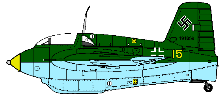
|
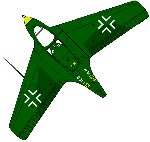
|
As far as can be determined, the cockpit interior is original. There are no missing items, and there doesn't seem to have been any repainting, although some of the painted labels look to have been done roughly by hand - maybe this was the case in the original construction. The glass in the ball tube of the turn and slip indicator is broken, but the control column and rudder operate smoothly and the hydraulic pump lever is equally free to move. There is a webbing pattern harness with simple metal spring clip fastener fitted. A while ago the main instrument panel was unfastened, and then allowed to hang free for a number of years, straining the hinge. The panel is now fixed closed, but the hinge is fragile.
There is no armament fitted to this aircraft, but at the port wing root there is an aperture for the bore sight tube (for example this is missing on Komet Wkr.Nr.191614 at Cosford). 191659 retains its engine mounted internally, which appears to be in good condition. The manufacturer's plate details this as a Walter 109-509.A.1.0, serial number 845, manufacturer's code being hnx.
A second engine is displayed alongside the Komet. This is a very special example, most likely a test version of the A-2 model for ground runs. The piping is different to all other engines. The thrust chamber is not the standard one: the cooling is performed by T-Stoff instead of C-Stoff. This was most likely done to increase the cooling capacity, since the T-Stoff volume is 3.18 times that of C-Stoff (due to the mixture ratio). This engine will not fit the Me 163B airframe, since the cooling pipes would interfere with the bulkhead just in front of the engine. This makes it likely that is a test article for ground runs. It also appears to have extra sensors installed. See the Walter HWK 109-509 site for a more thorough analysis of this engine.
Both dolly tyres look to be original, although are of slightly different patterns, but both have a smooth tread. The port is labelled 700x175 8-8013 C-1. The starboard has the following markings: 700x175 8-8013 C-1 U 20. The tailwheel is a pneumatic, smooth tyre, but no note was made of the type.
The photos concluding the report are also by Shamus Reddin.
General views |

|

|

|

|
Fuselage |
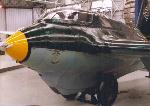
|
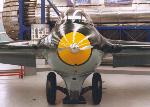
|
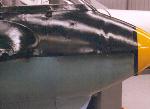
|

|
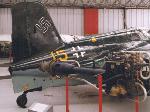
|

| |||
Wing |
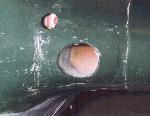
| |||
Cockpit |

|

|
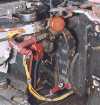
|
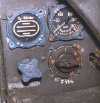
|
Engine |
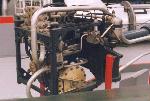
|

|
Another photo report was provided by Dave Brooks. He provided the following detail photographs taken during his visit in August 1999:
Fuselage |
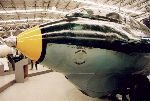
|
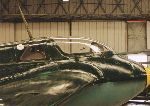
|
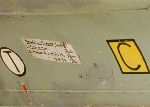
| |
Wing |
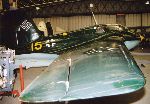
| |||
Landing gear |
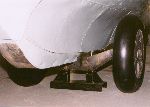
|

|
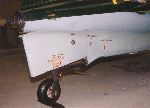
| |
Engine |
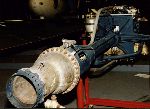
|

|
Grant Newman of the Museum of Flight at East Fortune provided another set of photographs, including many unique ones showing opened hatches and the interior. The first set of photographs also show the Komet being moved from Hangar 4 to its new position alongside the Spitfire in Hangar 1 (approximately March 2000).
General views |

|

|

|

|

| ||||
Fuselage |

| |||
Hatches/covers |
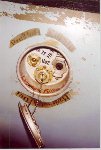
|

|
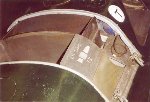
|
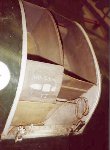
|
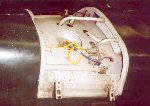
|
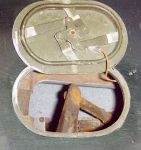
| |||
Cockpit |
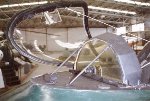
|

|
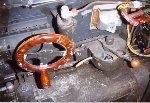
|
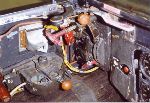
|
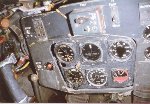
|

|
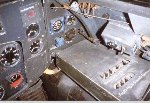
|
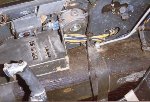
| |
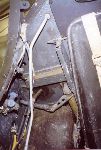
|
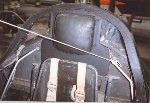
|
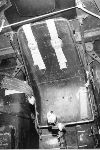
|

| |
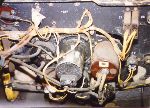
|